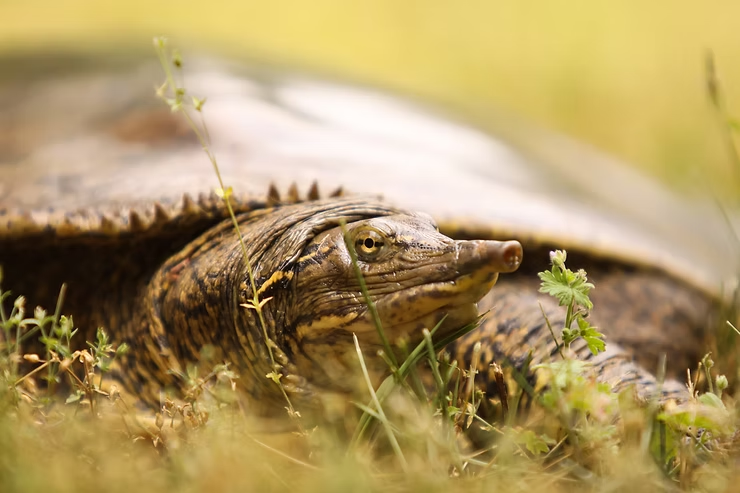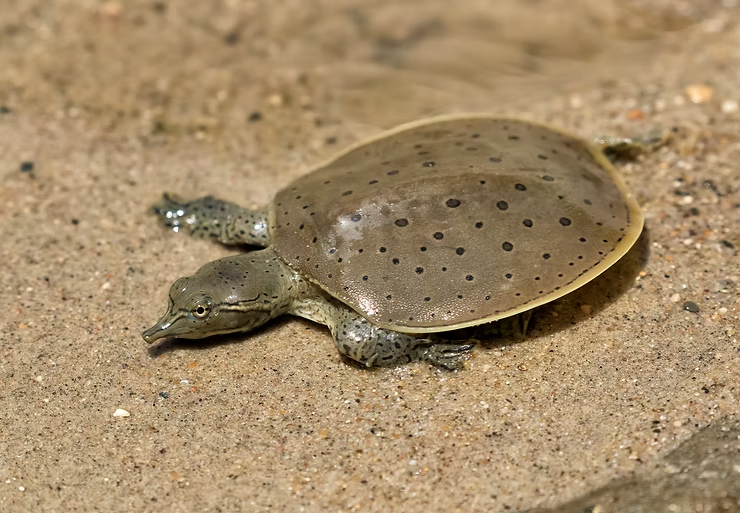Turtles with soft shells? They do exist
- Willy's Wilderness
- May 18, 2023
- 3 min read
Updated: Jul 24
World Turtle Day is May 23, but there is never a bad time to celebrate these awesome reptiles. Will County is home to familiar species such as the painted turtle, plus the Blanding’s turtle and common snapping turtle.

With so many species, it’s hard to stand out from the pack, but the spiny softshell turtle stands out from the crowd in more ways than one. Let’s look at some of the things that set these turtles apart.
Soft shells
As its name suggests, these turtles have soft, flat, leathery shells. Because of this, they don’t have individual scutes, the hexagonal-shaped scales on the top shell. Their shells are smooth and somewhat flexible.
Built-in defense
When turtles feel threatened, they tuck into their shells. Spiny softshell turtles have an extra defense: spines. The edges of the carapace (top shell) have small, thorn-like spines. Males typically have more than females. To avoid being seen by predators, these turtles will also bury themselves in the sand.
Words to know
Carapace: The upper shell of a turtle.
Genetics: The study of genes and heredity.
Omnivorous: Feeding on both plant and animal matter.
Scute: The bony plates on a turtle’s shell or on the back of a crocodile.
Semiaquatic: Living partly on land and partly on water.
Their scientific name, Apalone spinifera, is a reference to their shells. Apalone comes from the Greek word apalos, which means soft or tender. Spinifera is of Latin origin. Spina means thorn or spine, and ifer means bearing. Makes sense!
Snorkel snout

The spiny softshell turtle is well equipped to spend most of its life in the water — just look at its nose! The turtles can remain buried in the sand, with their long necks stretched and their piglike noses acting as snorkels. When looking for these turtles in the water, their long noses might be the first, or only, thing you see!
Gender reveal
Just like humans, the gender of spiny softshell hatchlings is determined by genetics. For other turtle species, such as the Blanding’s turtle, the gender of the hatchlings depends on what temperature the eggs were kept at during incubation. Nest temperatures closer to 90 degrees F will result in primarily female hatchlings, while temperatures below 75 degrees F will produce mostly males.
Need for speed
Turtles are slow-moving creatures, right? Not in the water! The spiny softshell turtle has
webbed feet, like a duck. This webbing helps them swim even faster than their semiaquatic friends like the painted turtle or red-eared slider. For us, it would be like paddling a canoe with a paddle versus a rake!
Despite these differences, spiny softshell turtles have a lot in common with other turtles. Let’s take a look.
Size
An adult female's carapace can be anywhere from 7 inches to 19 inches long, while the male's is much smaller, at 5 inches to 10 inches. They are just a little larger than some other turtles and are one of the largest freshwater turtle species.
Familiar menus
Like most other turtles, the spiny softshell turtle is omnivorous, meaning they are not picky eaters! The spiny softshell turtle will eat almost anything in the water that will fit into its mouth, which includes aquatic insects, crayfish, fish and sometimes algae. They will either hunt for their prey or bury themselves in the sand and wait for food to swim by.
Habitat and homes
Like many other turtles, spiny softshells like freshwater habitats, including ponds, lakes, rivers, tributaries and streams. They live in shallow water but can also be found as much as 32 feet deep. They generally can be found in areas with slow-moving waters with varying levels of vegetation. Spiny softshells prefer waters with sandy bottoms as well as clean, sandy banks. They are perfect for them to hide in. They can be found across the Midwest and as far north as Quebec, Canada, and as far south as New Orleans, Louisiana.
Catching some rays
Have you gone hiking on a sunny day and seen a group of turtles sharing a log in a pond? Turtles do not sunbathe for fun; they “sun” for survival! All turtles are cold blooded, meaning they cannot regulate their body temperature. Because of this, they seek out heat sources and hot spots to get warm.
Distinct coloring

Each turtle species has unique coloring. Hatchlings, or baby softshell turtles, might remind you of a chocolate chip silver dollar pancake. They are light tan with dark circles and are roughly the size of a quarter when they hatch. Males have similar coloring throughout their life. As females age, their shell becomes darker.
Have you seen a spiny softshell turtle? Keep an eye out for their snorkel snout next time you walk by a pond!
____________


